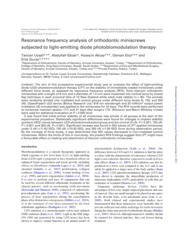Resonance frequency analysis of orthodontic miniscrews subjected to light-emitting diode photobiomodulation therapy
-
Eser Sahibi
TANCAN UYSAL
-
Tür
Makale
- Yayın Tarihi 2012
- DOI Numarası 10.1093/ejo/cjq166
-
Yayıncı
European Orthodontic Society
- Tek Biçim Adres Http://hdl.handle.net/11469/162
-
Konu Başlıkları
Photobiomodulation therapy
Orthodontic miniscrews
The aim of this prospective experimental study was to evaluate the effect of light-emitting diode (LED) photobiomodulation therapy (LPT) on the stability of immediately loaded miniscrews under different force levels, as assessed by resonance frequency analysis (RFA). Sixty titanium orthodontic miniscrews with a length of 8 mm and a diameter of 1.4 mm were implanted into cortical bone by closed flap technique in each proximal tibia of 15 New Zealand white adult male rabbits (n = 30). The animals were randomly divided into irradiated and control groups under different force levels (0, 150, and 300 cN). OsseoPulse® LED device (Biolux Research Ltd.) 618 nm wavelength and 20 mW/cm2 output power irradiation (20 minutes/day) was applied to the miniscrews for 10 days. The RFA records were performed at miniscrew insertion session (T1) and 21 days after surgery (T2). Wilcoxon and Mann–Whitney U-tests were used for statistical evaluation at P < 0.005 level.
It was found that initial primer stability of all miniscrews was similar in all groups at the start of the experimental procedure. Statistically significant differences were found for changes in implant stability quotient (ISQ) values between LED-photobiomodulated group and the control (0 cN, P = 0.001; 150 cN, P < 0.001; and 300 cN, P < 0.001). Significant increase was found in ISQ values of LPT applied miniscrews under 0 cN (+11.63 ISQ), 150 cN (+10.50 ISQ), and 300 cN (+7.00 ISQ) force during observation period. By the increase of force levels, it was determined that ISQ values decreased in non-irradiated control miniscrews. Within the limits of this in vivo study, the present RFA findings suggest that LPT might have a favourable effect on healing and attachment of titanium orthodontic miniscrews.


 Tam Metin
Tam Metin

